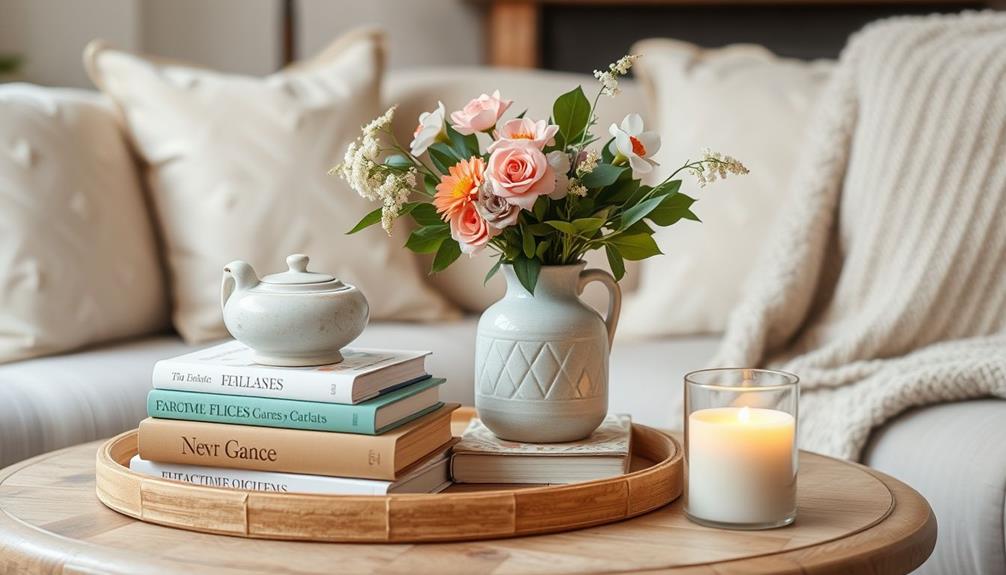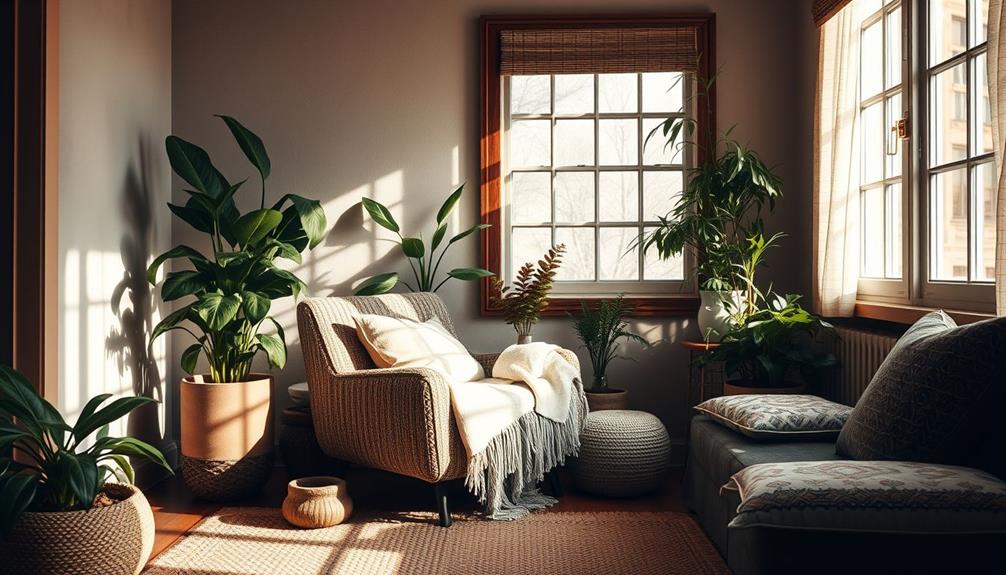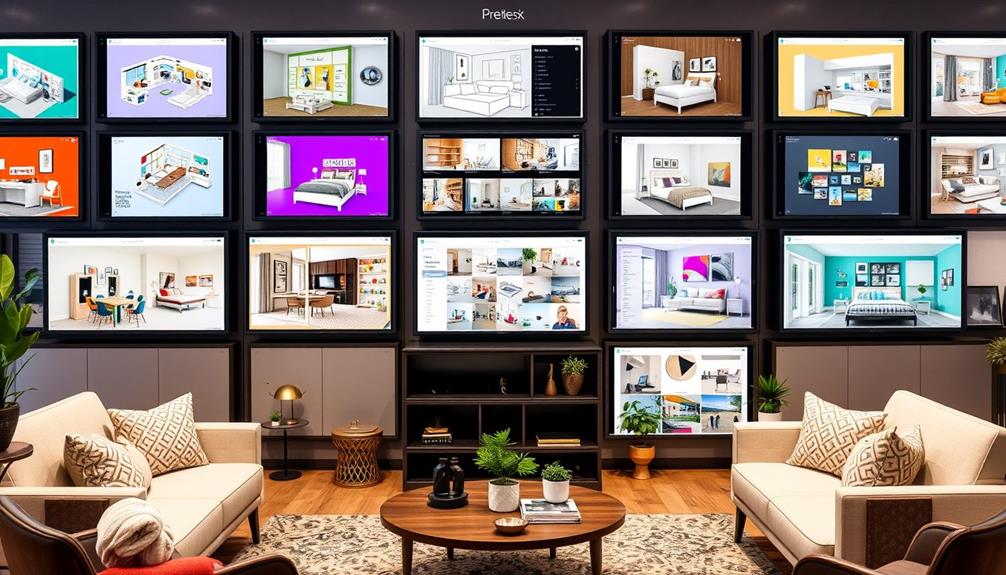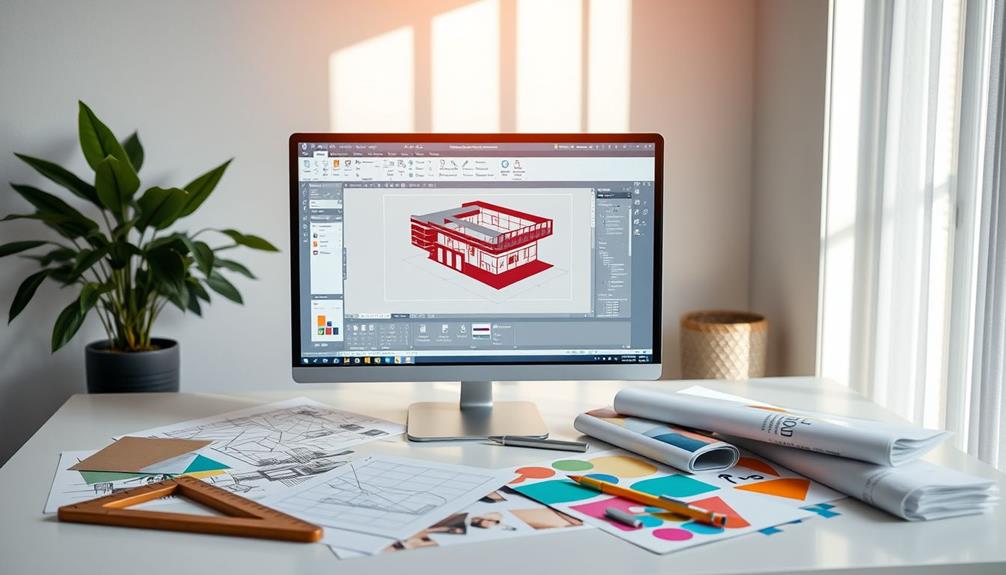To create a vignette in your interior design, choose a suitable space like a shelf or table. Start by selecting three or more decorative items, ensuring they vary in height and color for visual interest. Pick an anchor object, such as a lamp or sculpture, to ground your arrangement. Layer smaller items around it, grouping them in odd numbers for a dynamic look. Incorporate textures and greenery to add depth. Feel free to swap out seasonal decor to keep your vignette fresh and engaging. If you're interested in more tips and tricks, there's plenty more to explore. Consider incorporating a pop of color into your vignette to create a focal point. You can also experiment with different color palette ideas, such as monochromatic or complementary schemes, to achieve a cohesive and harmonious look. Don’t be afraid to mix and match different patterns and textures within your chosen color palette to add visual interest and depth to your vignette.
Key Takeaways
- Select a cohesive color palette of two to three colors to unify decorative objects in your vignette.
- Use an anchor object as a focal point, layering smaller items around it for balance and interest.
- Incorporate height variation and diverse textures to enhance visual appeal and prevent monotony.
- Group objects in odd numbers and overlap them slightly to create dynamic compositions.
- Regularly refresh your vignette by swapping seasonal decor or introducing new items for a lively display.
Understanding Vignettes

Understanding vignettes can transform your interior design approach. A vignette is a small grouping of decorative objects that enhances the visual appeal and personality of your space. You might find them adorning tables, shelves, or mantels, adding a personal touch to your home. The term "vignette" comes from various fields, like literature and film, where it describes a brief, evocative portrayal.
Creating a vignette involves selecting three or more items that tell a story or convey a theme. This allows you to express your unique style through home decor. When arranging your vignette, incorporating varying heights and a cohesive color scheme can create visual interest and balance, making your display more engaging.
One of the best aspects of vignettes is their dynamic nature; you can easily change them to refresh your decor without much effort or commitment. Whether you want to celebrate the seasons or highlight cherished memories, vignettes offer a flexible way to showcase your personality.
Selecting the Right Space

Choosing the right space for your vignette can make all the difference in how it enhances your home. Ideal locations include end tables, nightstands, entry tables, or mantels, where your vignette can serve as a focal point in the room.
Start by editing the existing items in your chosen area; decide which elements to keep or remove for a clean, curated look. Since most items aren't fixed to walls, you can easily relocate them, allowing for experimentation with different arrangements and styles.
When selecting the vignette area, consider the scale and proportion of the space to guarantee it complements the surrounding decor without overwhelming it. A well-sized grouping of objects will create visual balance and harmony.
Gathering Decorative Accessories

How can you transform your space with carefully selected decorative accessories? Start by shopping your home for items like books, vases, and personal mementos. Aim for a cohesive color palette of two or three colors to create visual harmony. Grouping your objects thoughtfully will enhance the overall aesthetic.
Here's a quick guide to help you gather your accessories:
| Accessory Type | Examples |
|---|---|
| Decorative Trays | Wood, metal, or ceramic |
| Natural Elements | Fresh flowers, greenery |
| Personal Mementos | Family photos, travel souvenirs |
Look for versatile items that can adapt to various vignettes, like decorative trays. These not only unify your arrangement but also define spaces for your accessories. Don't shy away from incorporating seasonal elements or unique finds from thrift stores and local markets; they can reflect your personal style without breaking the bank.
Choosing an Anchor Object

After gathering your decorative accessories, the next step is to identify an anchor object that will serve as the focal point of your vignette. This object is vital as it helps establish the overall theme and guides the arrangement of surrounding items. Ideal anchor objects include larger decorative pieces like lamps, sculptures, or artworks that naturally draw the eye and provide height.
When selecting your anchor object, consider its color, texture, and style to guarantee it complements the other accessories in the vignette. A well-chosen anchor object not only grounds the vignette but also sets the tone for the entire arrangement, making it essential for cohesive design.
You'll want to position the anchor object first, creating a stable base for your vignette.
Once your anchor object is in place, layer smaller items around it, incorporating objects of varying heights for balance and visual interest. This layering technique allows you to create depth and dimension, enhancing the overall appeal of your vignette.
Arrangement Techniques

Creating an engaging vignette relies heavily on effective arrangement techniques. Start with your tallest item as an anchor piece; this establishes height and creates a focal point for your vignette. Next, layer your accessories from back to front, placing the tallest items in the back and smaller ones in the front. This arrangement adds depth and visibility.
To enhance visual appeal, group your objects in odd numbers, like three or five. This creates a dynamic composition that draws the eye. Don't hesitate to overlap objects slightly; this adds interest and prevents a uniform look.
Regularly step back and evaluate your arrangement to verify balance. Adjust the positioning of items as needed to create a pleasing display.
Here's a quick reference table for effective arrangement techniques:
| Technique | Description | Example |
|---|---|---|
| Start with a tall anchor | Use the tallest item as a focal point. | A large vase or sculpture. |
| Layering accessories | Arrange items from back to front for depth. | Tall back, small front. |
| Odd number groupings | Group items in sets of three or five. | Three books with a plant. |
| Overlapping | Slightly overlap objects to create interest. | Picture frame over a book. |
| Step back and evaluate | Regularly check for balance and aesthetics. | Adjust as needed. |
Height Variation in Design

Incorporating height variation in your vignette can greatly enhance its visual appeal and engage viewers more effectively. By mixing heights among your decorative vignettes, you create visual interest that draws the eye and makes the arrangement more dynamic. Aim to include at least three different heights among your objects to prevent a monotonous look.
Use taller items, like sculptures or tall vases, as focal points to anchor your vignette. These pieces will naturally catch attention, while shorter items can provide balance and support. Layering is key; place shorter objects in front of taller ones to add depth and dimension, inviting exploration of your vignette.
Don't hesitate to use risers or decorative stands to elevate certain pieces. This technique not only helps achieve the desired height variation but also creates a polished appearance that enhances the overall composition.
Color Coordination Tips

When you're choosing colors for your vignette, start with a neutral or metallic palette as your base.
Then, add pops of color that complement your existing decor to create a cohesive look.
Remember to pull color cues from elements like upholstery or artwork to guarantee everything feels harmonized.
Neutral and Metallic Palettes
A well-chosen neutral or metallic palette can serve as a versatile backdrop for your vignette, seamlessly blending with different decor styles and seasonal themes. Neutral palettes, such as whites, grays, and beiges, create a calming environment, while metallic tones like gold and silver add a touch of glam and sophistication.
In line with current trends, consider incorporating modern farmhouse decor elements to enhance the rustic charm of your vignette.
To guarantee harmony within your vignette, coordinate these colors with existing room elements, such as upholstery or wall colors. Decorative boxes or trays in neutral tones can enhance your vignette's functionality and style without overwhelming the arrangement.
When integrating pops of color, consider bold accessories, artwork, or florals that stand out against your neutral or metallic base. These vibrant elements can elevate the visual interest of your vignette, making it more engaging.
Just remember to keep the overall look cohesive; the pops of color should complement rather than clash with your chosen palette.
Pops of Color
To make your vignette truly pop, adding vibrant accents can create visual excitement and draw the eye. Start by incorporating a limited color palette of two to three hues for cohesion while allowing for those striking pops of color. Use decorative items like vases or cushions in bold colors to create focal points that captivate attention.
When grouping decorative objects, coordinate the colors with your existing room decor. For example, match a vase to an accent wall or artwork for harmony. You can also draw inspiration from nature—fresh flowers or greenery can introduce vibrant touches that complement your color scheme.
To enhance organization and visual interest, consider using decorative boxes or trays in complementary colors. This way, your pops of color will feel well-integrated into the overall design.
Here's a simple table to help you visualize your color choices:
| Color Choice | Decorative Object | Natural Element |
|---|---|---|
| Bold Blue | Ceramic Vase | Blue Hydrangeas |
| Vibrant Yellow | Throw Pillow | Sunflowers |
| Rich Green | Decorative Tray | Potted Succulent |
| Deep Red | Glass Candle Holder | Red Roses |
| Soft Pink | Art Print | Pink Peonies |
Cohesive Room Elements
Creating a cohesive look in your vignette starts with selecting a well-defined color palette. Choose two to three complementary colors that not only work together but also tie in with the existing features of your room, like furniture upholstery or wall colors. This guarantees your beautiful vignette harmonizes with the overall interior design.
Next, incorporate decorative items that echo these colors. Think about boxes, vases, or artwork that match or reflect your chosen palette. This approach enhances visual unity and makes your vignette feel intentional.
Consider using a neutral or metallic base for your vignette. This allows those pops of color from accessories to stand out without overwhelming the space.
Regularly evaluate the color balance within your vignette, adjusting elements as needed to maintain harmony and visual appeal throughout the room.
Adding Greenery and Texture

Incorporating vibrant plants and textured elements into your vignette instantly breathes life into the space.
By adding greenery and texture, you create a dynamic environment that draws the eye and invites interaction.
Here are some effective ways to achieve this:
- Mix plant types: Use potted succulents alongside fresh-cut flowers for a pop of color and varied shapes.
- Incorporate diverse materials: Blend glass, wood, and metal to create a visually interesting display that enhances the overall aesthetic.
- Utilize textured objects: Incorporate woven baskets or ceramic vases to add depth and contrast to your arrangement.
- Select organic elements: Ferns or eucalyptus can soften the vignette, contributing to a more inviting atmosphere.
Seasonal Vignette Ideas

As the seasons change, so can your vignette, allowing you to refresh your space and reflect the beauty of nature throughout the year. When creating a vignette, think about incorporating seasonal elements that resonate with each time of year.
For fall, use natural objects in your home like pumpkins, gourds, and warm-toned leaves to create a cozy atmosphere that celebrates harvest time.
In winter, evergreen branches and pinecones paired with metallic accents, such as silver or gold, evoke a festive elegance perfect for holiday decor.
As spring arrives, feature fresh flowers in pastel colors along with light fabrics and decorative eggs to symbolize renewal and the beauty of the season.
Summer calls for a vibrant display; consider using colorful fruits, seashells, and bright textiles to reflect the lively essence of this sunny time.
Don't forget about holiday-specific themes! Adapt your vignette with colors and symbols that match the celebration—red and green for Christmas, or orange and black for Halloween.
Reviewing and Revising Your Vignette

To keep your vignette looking its best, regularly step back and assess it from different angles.
Incorporating elements such as stylish wall clocks can enhance both the aesthetics and functionality of your display.
Make adjustments to achieve balance and visual appeal, and don't hesitate to refresh the display with new items.
Regular Evaluation Process
Stepping back to regularly evaluate your vignette is essential for maintaining its visual appeal and balance. This process allows you to see what works and what doesn't, helping you create a harmonious display.
Here are four key steps to guide your evaluation:
- Assess from Different Angles: Walk around your vignette to view it from various perspectives, ensuring balance and visual interest.
- Check Cohesion: Make sure colors, textures, and heights complement each other. A well-arranged stack of books, for instance, can serve as a focal point.
- Encourage Change: Treat your vignette as a dynamic display. Periodically swap out items or reposition accessories to keep it fresh and aligned with your style.
- Document Inspiration: Take photos of your favorite arrangements. These can inspire future redesigns and help you remember successful combinations.
Adjusting for Balance
Achieving balance in your vignette is essential for creating a visually appealing display. Regularly step back and evaluate your arrangement from different angles to guarantee it looks balanced. Adjusting for balance involves focusing on height variation and spacing among your items.
Here's a simple way to visualize your adjustments:
| Height Variation | Spacing |
|---|---|
| Tall, slender vase | Space between items |
| Medium sculpture | Cluster small items |
| Low, wide bowl | Guarantee visual flow |
Experiment with layering—move items forward or backward to add depth and interest. Remember the rule of thirds; this helps prevent any single area from feeling overcrowded or too bare. If something feels off, don't hesitate to reposition accessories or swap out elements to refresh the look.
Refreshing With New Items
Revitalizing your vignette not only rejuvenates your space but also keeps it aligned with your evolving tastes and seasonal themes.
To refresh your vignette, consider these four impactful strategies:
- Evaluate Regularly: Step back and assess your vignette's balance and visual appeal. Make adjustments to maintain freshness.
- Swap Accessories: Replace seasonal decor or add new elements to keep things dynamic. Odd numbers often create a more engaging look, so try using three or five items.
- Experiment with Arrangements: Reposition existing items or introduce finds that reflect your current interests. A new configuration can breathe life into your display.
- Incorporate Unique Touches: Use recent thrift store treasures or personal mementos. These pieces not only tell your story but also provide a pop of color and character.
Conclusion
Creating a vignette can truly transform your space, bringing it to life with personality and charm. Remember, it's all about striking a balance and telling a story through your chosen elements. Once you've assembled your pieces, don't be afraid to tweak things until it feels just right. With a little patience and creativity, you'll have a stunning vignette that'll really catch the eye. So go ahead, take the plunge, and watch your interior design dreams come to fruition!









